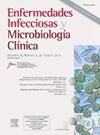Screening for Crimean-Congo Haemorrhagic Fever Virus antibodies in humans living in an endemic area of Spain
IF 2.6
4区 医学
Q3 INFECTIOUS DISEASES
Enfermedades infecciosas y microbiologia clinica
Pub Date : 2025-01-01
DOI:10.1016/j.eimc.2024.09.006
引用次数: 0
Abstract
Introduction
Crimean-Congo haemorrhagic fever (CCHF) is an emerging tick-borne viral disease. It has been described in Spain in both ticks and humans. Until July 2024 most cases have been described in the central-western part of the Iberian Peninsula. This study aims to assess the seroprevalence of antibodies against CCHF virus (CCHFV) in humans in the area that has reported the highest number of cases in Spain.
Methods
The study was conducted to estimate the seroprevalence of antibodies against CCHFV antibodies among patients referred to a hospital located in the central-western area of Spain, an endemic area for CCHFV of Spain. Patients were recruited from April 1, 2023, to June 30, 2023. A commercial ELISA was used to detect serum antibodies against the CCHFV.
Results
We screened 658 samples from 370 (56.2%) men, with a mean (±SD) age of 58.6 years (±14.3). Of these, 4 were IgG positive, representing an IgG seropositivity of 0.6% (95% CI, 0.01–1.19). None of these four patients recalled having a clinical picture that strongly suggested CCHF.
Over the study period, in the population analysed in an area with circulation of CCHFV the seroprevalence of antibodies was 0.6%.
Conclusion
Our results suggest active circulation of the virus in humans in western Spain. Although the risk of developing CCHF is currently considered low, physicians should be alert to the imminent possibility of developing new cases of CCHF.
对居住在西班牙某流行地区的人进行克里米亚-刚果出血热病毒抗体筛查
克里米亚-刚果出血热(CCHF)是一种新出现的蜱传病毒性疾病。在西班牙,蜱虫和人类都发现了这种疾病。直到2024年7月,大多数病例都发生在伊比利亚半岛的中西部地区。本研究旨在评估西班牙报告病例数最多的地区人类抗CCHF病毒(CCHFV)抗体的血清流行率。方法对西班牙CCHFV疫区西班牙中西部某医院转诊患者血清CCHFV抗体阳性率进行分析。患者于2023年4月1日至2023年6月30日招募。采用商用ELISA检测CCHFV血清抗体。结果从370例(56.2%)男性中筛选出658例样本,平均(±SD)年龄为58.6岁(±14.3)。其中4例IgG阳性,IgG血清阳性为0.6% (95% CI, 0.01-1.19)。这4例患者均没有强烈提示CCHF的临床表现。在研究期间,在CCHFV流行地区分析的人群中,抗体的血清阳性率为0.6%。结论该病毒在西班牙西部人群中传播活跃。虽然目前认为发生CCHF的风险较低,但医生应警惕即将发生新病例的可能性。
本文章由计算机程序翻译,如有差异,请以英文原文为准。
求助全文
约1分钟内获得全文
求助全文
来源期刊
CiteScore
2.10
自引率
8.00%
发文量
194
审稿时长
29 days
期刊介绍:
Hoy está universalmente reconocida la renovada y creciente importancia de la patología infecciosa: aparición de nuevos agentes patógenos, de cepas resistentes, de procesos con expresión clínica hasta ahora desconocida, de cuadros de una gran complejidad. Paralelamente, la Microbiología y la Infectología Clínicas han experimentado un gran desarrollo como respuesta al reto planteado por la actual patología infecciosa. Enfermedades Infecciosas y Microbiología Clínica es la Publicación Oficial de la Sociedad Española SEIMC. Cumple con la garantía científica de esta Sociedad, la doble función de difundir trabajos de investigación, tanto clínicos como microbiológicos, referidos a la patología infecciosa, y contribuye a la formación continuada de los interesados en aquella patología mediante artículos orientados a ese fin y elaborados por autores de la mayor calificación invitados por la revista.

 求助内容:
求助内容: 应助结果提醒方式:
应助结果提醒方式:


